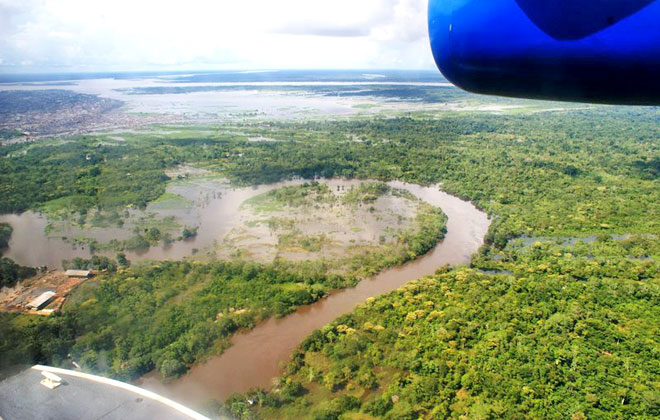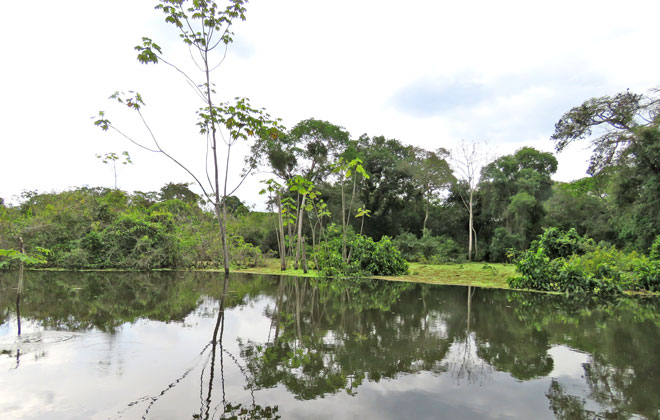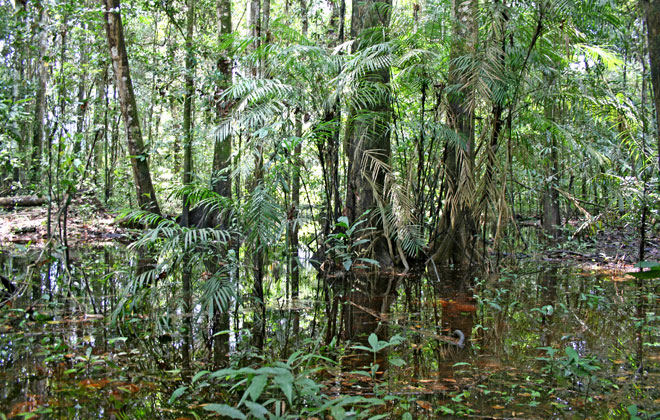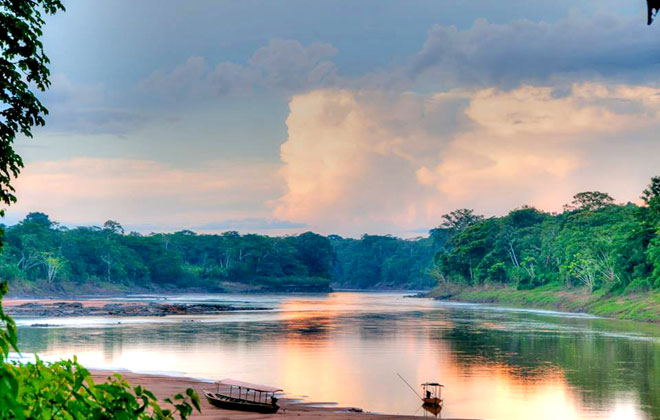
Aerial view of an Amazonian white-water river flooded during the wet season.
Definition: Flooded Tropical Evergreen Forests are seasonally covered by water that spills over from the regular course of Amazonian Rivers. Some flooded forests may remain covered by water for up to six months of the year.
How does this Happen?
Most water in Amazonian Rivers originates from rainfall on the eastern slope of the Andes. When one talks about the rainy season in Amazonia, we are really referring to the rainy season in the Eastern Andes. Rainfall in Amazonia has little variation throughout the year.
As more and more water discharges onto Amazonian rivers, the regular river course can no longer contain the water, which overflows onto low-lying floodplain adjacent to the rivers.
Overall, the time these forests remain flooded depends on the local geography on the river floodplains. Low-lying areas remain flooded for longer periods of time.
Is the Flooded Tropical Evergreen Forest different from the surrounding forests?
Flooded forest and non-flooded forest, are similar floristically and structurally but flooded forests have a greater number of species of plants tolerant of long periods underwater, particularly in areas that remain flooded for long periods of time.
The understory of forests that remain covered in water for long periods is generally open and supports a low plant diversity.
What is the extent of the flooding?
Flooding occurs every year along the extensive network of Amazonian Rivers. It is estimated that up to 4 percent of the Amazonian forest is flooded every year representing approximately 250,000 Km2. Flooded areas can extend about 20 km from the river banks during the rainy season. During the flooding period, waters may rise between 7.5 m and 15 m their levels during the dry season.
Are there different types of Tropical Evergreen Flooded Forests?
There are mainly two types of Flooded Forest, Varzea, and Igapo Forest.
- Varzea Forest: Occurs along the floodplain of whitewater rivers, which originate from rainfall in the Andean Mountain chain. Whitewater contains sediments and nutrients collected along their long trajectory from the Andean Mountains. Varzea forests are structurally similar but support a less diverse plant community than the adjacent Terra Firme Forest. Varzea forests are generally flooded for approximately 2 months or less.
- Igapo Forests Occurs along the floodplain of blackwater rivers and channels. Blackwater rivers originate from rainfall in Amazonia, are rich in tannins but poor in nutrient content. Igapo forests are flooded for periods of five to six months and even longer depending on the local geography. Flooded forests vary in plant diversity and appearance. Generally, the longer time the forest is flooded, the shorter and floristically less diverse the forest is.

View of black-water flooded forest.

Interior of flooded forest.

Amazonian River during the dry season. Water is contained within the river course and river banks are visible.
See more Neotropical Bird Habitats.
References:
Parolin, P., L.V. Ferreira, A.L.K.M. Albernaz, & S. Almeida (2004). “Tree Species Distribution in Varzea Forests of Brazilian Amazonia”. Folia Geobotanica. 39 (4): 371–383.
Sears, Robin, Seasonally flooded river basins of Brazil, Peru and Bolivia (NT0128), WWF: World Wildlife Fund, retrieved 2017-03-27.
Prance, G. T. (1979). “Notes on the vegetation of Amazonia III. The terminology of Amazonian forest types subject to inundation”. Brittonia. 31 (1): 113–121.
Goulding, M.; N.J.H. Smith; D.J. Mahar (1996). Floods of fortune: ecology and economy along the Amazon. New York: Columbia University Press.
Bodmer, Richard E. “Responses of Ungulates to Seasonal Inundations in the Amazon Floodplain.” Journal of Tropical Ecology. 6.2 (1990): 191-201.
Borges, Sergio Henrique, and Andre Carvalhaes. “Bird species of black water inundation forests in the Jaú National Park (Amazonas state, Brazil): their contribution to regional species richness.” Biodiversity and Conservation. 9. (2000): 201-214.